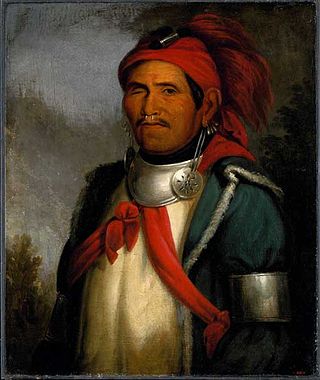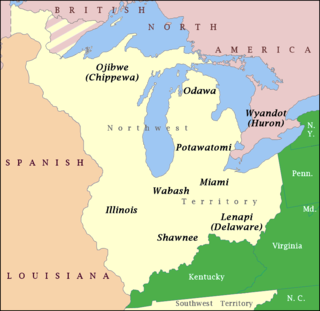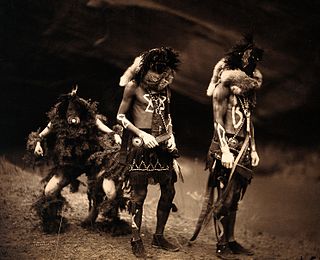Related Research Articles

The Battle of Tippecanoe was fought on November 7, 1811, in Battle Ground, Indiana, between American forces led by then Governor William Henry Harrison of the Indiana Territory and tribal forces associated with Shawnee leader Tecumseh and his brother Tenskwatawa, leaders of a confederacy of various tribes who opposed European-American settlement of the American frontier. As tensions and violence increased, Governor Harrison marched with an army of about 1,000 men to attack the confederacy's headquarters at Prophetstown, near the confluence of the Tippecanoe River and the Wabash River.

Tecumseh was a Shawnee chief and warrior who promoted resistance to the expansion of the United States onto Native American lands. A persuasive orator, Tecumseh traveled widely, forming a Native American confederacy and promoting intertribal unity. Even though his efforts to unite Native Americans ended with his death in the War of 1812, he became an iconic folk hero in American, Indigenous, and Canadian popular history.

Pontiac's War was launched in 1763 by a loose confederation of Native Americans who were dissatisfied with British rule in the Great Lakes region following the French and Indian War (1754–1763). Warriors from numerous nations joined in an effort to drive British soldiers and settlers out of the region. The war is named after Odawa leader Pontiac, the most prominent of many indigenous leaders in the conflict.

Tecumseh's War or Tecumseh's Rebellion was a conflict between the United States and Tecumseh's Confederacy, led by the Shawnee leader Tecumseh in the Indiana Territory. Although the war is often considered to have climaxed with William Henry Harrison's victory at the Battle of Tippecanoe in 1811, Tecumseh's War essentially continued into the War of 1812 and is frequently considered a part of that larger struggle. The war lasted for two more years, until 1813, when Tecumseh and his second-in-command, Roundhead, died fighting Harrison's Army of the Northwest at the Battle of the Thames in Upper Canada, near present-day Chatham, Ontario, and his confederacy disintegrated. Tecumseh's War is viewed by some academic historians as the final conflict of a longer-term military struggle for control of the Great Lakes region of North America, encompassing a number of wars over several generations, referred to as the Sixty Years' War.

The Shawnee are a Native American people of the Northeastern Woodlands. Their language, Shawnee, is an Algonquian language.

Tenskwatawa was a Native American religious and political leader of the Shawnee tribe, known as the Prophet or the Shawnee Prophet. He was a younger brother of Tecumseh, a leader of the Shawnee. In his early years Tenskwatawa was given the name Lalawethika, but he changed it around 1805 and transformed himself from a hapless, alcoholic youth into an influential spiritual leader. Tenskwatawa denounced the Americans, calling them the offspring of the Evil Spirit, and led a purification movement that promoted unity among the Indigenous peoples of North America, rejected acculturation to the American way of life, and encouraged his followers to pursue traditional ways.
Buckongahelas together with Little Turtle & Blue Jacket, achieved the greatest victory won by Native Americans, killing 600. He was a regionally and nationally renowned Lenape chief, councilor and warrior. He was active from the days of the French and Indian War through the Northwest Indian Wars, after the United States achieved independence and settlers encroached on territory beyond the Appalachian Mountains and Ohio River. The chief led his Lenape band from present-day Delaware westward, eventually to the White River area of present-day Muncie, Indiana.
Squ-sacht-un, also known as John Slocum, was a member of the Squaxin Island Tribe, Coast Salish, and a reputed holy man and prophet who founded the Indian Shaker Church in 1881.

The siege of Fort Detroit was an ultimately unsuccessful attempt by North American Natives to capture Fort Detroit during Pontiac's Rebellion. The siege was led primarily by Pontiac, an Ottawa chief and military leader. This rebellion would be one of the catalysts that hastened the declaration of the Proclamation of 1763 which would eventually precipitate the events leading to the American Revolution.

On July 26, 1764, four Delaware (Lenape) Native Americans entered a settlers' log schoolhouse in the Province of Pennsylvania and killed the schoolmaster, Enoch Brown, and ten students. One other student named Archie McCullough was wounded. The massacre is the first school shooting recorded in U.S. history. Historian Richard Middleton described the massacre as "one of the most notorious incidents" of Pontiac's War.

Leatherlips (1732–1810) was a Wyandot Native American leader of the late 18th and early 19th century.
Leatherlips had three Wyandot names. The one most often used was SHA‑TE‑YAH‑RON‑YA but he was sometimes referred to as THA‑TEY‑YAN‑A‑YOH. In later years he was called SOU‑CHA‑ET‑ESS, which means "Long Gray Hair". He was of the Porcupine Clan as was his great friend, Chief Tarhe, and he was related to Roundhead, Splitlog and Battise, noted Wyandot warriors of that period.

The Northwestern Confederacy, or Northwestern Indian Confederacy, was a loose confederacy of Native Americans in the Great Lakes region of the United States created after the American Revolutionary War. Formally, the confederacy referred to itself as the United Indian Nations, at their Confederate Council. It was known infrequently as the Miami Confederacy since many contemporaneous federal officials overestimated the influence and numerical strength of the Miami tribes based on the size of their principal city, Kekionga.

Native American religions are the spiritual practices of the Native Americans in the United States. Ceremonial ways can vary widely and are based on the differing histories and beliefs of individual nations, tribes and bands. Early European explorers describe individual Native American tribes and even small bands as each having their own religious practices. Theology may be monotheistic, polytheistic, henotheistic, animistic, shamanistic, pantheistic or any combination thereof, among others. Traditional beliefs are usually passed down in the forms of oral histories, stories, allegories, and principles.

Tecumseh's confederacy was a confederation of indigenous peoples in the Great Lakes region of North America that began to form in the early 19th century around the teaching of Tenskwatawa, called The Prophet by his followers. The confederation grew over several years and came to include several thousand warriors. Shawnee leader Tecumseh, the brother of The Prophet, developed into the leader of the group as early as 1808. Together, they worked to unite the various tribes against the European settlers who had been crossing the Appalachian Mountains and settling on their land.
L'Arbre Croche, known by the Odawa people as Waganagisi, was a large Odawa settlement in Northern Michigan. The French called it L'Arbre Croche for the large crooked tree that marked the center of the settlement and was visible for many miles. It covered the region from Harbor Springs to Cross Village in present-day Emmet County, Michigan.
Scattamek was a Lenape living in the Ohio Country during the 18th century. He was a religious leader later termed a prophet who continued and built on the teachings of Neolin. Their teachings influenced many of the surrounding tribes, including the Shawnee, the Miami, and Wea. Scattamek is known to have been teaching during the 1770s. The teachings were largely based on earlier traditions, but their teachings focused on the need to return to the tribe's ancestral ways, giving up European dress, liquor, and firearms. They blamed their misfortunes on the gods' anger with their adoption of European customs. Scattamek had particular influence on Tenskwatawa, who led a nativist revival during the early 19th century that catalyzed tribal support for Tecumseh's War during the 1810s.
A number of prominent Native Americans have protested against the social and cultural damage inflicted by alcohol on indigenous communities, and have campaigned to raise awareness of the dangers of alcohol and to restrict its availability to Native populations. Initially, these activists resisted the use of rum and brandy as trade items during the colonial era, in an effort to protect Native Americans from cultural changes they viewed as destructive. Later activists framed temperance in terms of Christianity, conforming to the broader temperance movement in the United States. Others led revitalization movements to restore Native American dignity by reverting to traditional customs and ceremonies or attempted to establish alcohol-free communities. During the 1800s several religious movements combined tradition with Christianity to attract a wider following. Modern-day addiction specialists integrate the psychology of substance abuse treatment with traditional rituals and symbolism and with community rehabilitation to reduce stressors and help recovering alcoholics maintain a healthy lifestyle.

Quatawapea or John Lewis, also known as Captain Lewis and Colonel Lewis and ‘’’Captain Johnny’’’, was a Shawnee leader for whom Lewistown, Ohio, is named.

Tamaqua or Tamaque, also known as The Beaver and King Beaver, was a leading man of the Unalachtigo (Turkey) phratry of the Lenape people. Although the Haudenosaunee in 1752 had appointed Shingas chief of the Lenape at the Treaty of Logstown, after the French and Indian War Tamaqua rose in prominence through his active role as peace negotiator, and was acknowledged by many Lenape as their "king" or chief spokesman. He was among the first to hand over English captives at the end of the French and Indian War and was active in peace negotiations at the conclusion of Pontiac's War. By 1758, he was recognized as one of three principal leaders of the Lenape, being the primary spokesman for the western Lenape in the Ohio Country. He founded the town of Tuscarawas, Ohio, in 1756 and died there in 1769 or 1771.
Beata (1769–unknown) was a Lenape woman who was instrumental in the revival and adaptation of Indigenous religious and cultural practices among the Lenape (Delaware) and other native groups in what is today central Indiana. Her visions and other abilities became famous and known throughout the region, drawing demand for her services from other Indigenous groups and suspicion from Euro-American settlers and US Government authorities.
References
- 1 2 John, Donald (2005-01-01). "Neolin". Encyclopedia of Religion. HighBeam Research. Archived from the original on 2018-11-14. Retrieved 2012-11-11.
- ↑ Trafzer, Clifford E. As long as the grass shall grow and rivers flow a history of Native Americans. Fort Worth: Harcourt College, 2000
- ↑ Parkman, Francis (1994). The conspiracy of Pontiac and the Indian war after the conquest of Canada. 1: To the Massacre at Michillimackinac (10. ed., rev ed.). Lincoln: Univ. of Nebraska Pr. ISBN 978-0-8032-8733-4.
- ↑ Cave, Alfred A. (1999). "The Delaware Prophet Neolin: A Reappraisal". Ethnohistory. Duke University Press. p. 271. JSTOR 482962.
- ↑ Voelker, David J. (2005). "John M'Cullough, Recollection of the Delaware Prophecy (of 1760s) 1808". History Tools. p. 273. Archived from the original on 22 December 2015. Retrieved 30 Dec 2015.
Source: "A Narrative of the Captivity of John M'Cullough, Esq.," in Archibald Loudon, A Selection of Some of the Most Interesting Narratives of Outrages Committed by the Indians in Their Wars with the White People, vol. 1. (1888 reprint of 1808 edition), 272-276
- ↑ Dowd, Gregory E (1992). A Spirited Resistance: The North American Indian Struggle For Unity, 1745-1815. Baltimore, MD: Johns Hopkins University Press. p. 33.
- ↑ Hunter, Charles E. (1971). "The Delaware Nativist Revival of the Mid-Eighteenth Century". Ethnohistory. Duke University Press. p. 46. JSTOR 481593.
- ↑ Ojibwa (2011-10-29). "Neolin: the Delaware Prophet". Native American Netroots. Retrieved 2012-11-11.
- ↑ "Neolin". Ohio History Central. 1 July 2005. Retrieved 28 August 2012.
- ↑ "Chiefs-Ottawa, Neolin Biography". Galafilm, Montreal. Archived from the original on 2002-12-31. Retrieved 2012-11-11.
- ↑ Bell, Ashley Neonta. "Neolin and Tenskwatawa: A Comparison of Two Nativist Prophets" . Retrieved 2012-11-11.
- ↑ Wallace, Anthony F. C.; Steen, Sheila K. (1972). The death and rebirth of the Seneca. Vintage Books, a division of Random House. ISBN 978-0-394-71699-2.